Gyantse Dzong: An Architectural Marvel and Spiritual Haven in Tibet
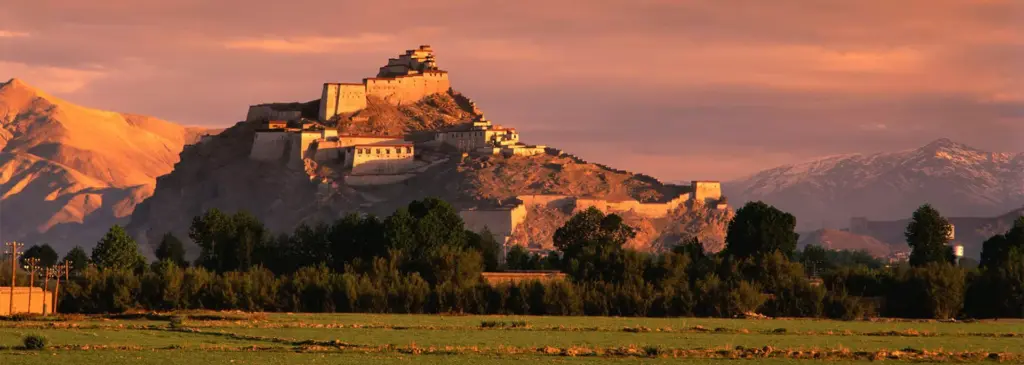
An Essential Guide to Visiting Gyantse Dzong
Perched majestically atop a hill overlooking the charming town of Gyantse, the Gyantse Dzong is a living testament to Tibet’s storied past and architectural prowess. With its rugged stone walls and sweeping views of the surrounding landscape, this fortress not only offers a glimpse into the rich tapestry of Tibetan history but also reveals the indomitable spirit of its people. Legend has it that the Dzong was inspired by the grand Potala Palace in Lhasa, crafted from a radish sketch that was lost to time. Yet, what it lacks in size, Gyantse Dzong compensates with its dramatic history, breathtaking vistas, and intricate murals that echo the artistic heritage of the region.
As you ascend the winding paths to its heights, prepare to be captivated by the panoramic views of the whitewashed houses, lush valleys, and the iconic Kumbum Stupa below. The air is imbued with stories of bravery, particularly from the heroic Tibetan defenders who valiantly resisted British forces in 1904, choosing honor over surrender. A visit to Gyantse Dzong is not merely a journey through time; it’s an invitation to connect with the resilient spirit of Tibet, where every stone and mural whispers tales of triumph, tragedy, and the timeless beauty of this sacred land. Whether you are a history buff, an adventure seeker, or simply in search of breathtaking landscapes, Gyantse Dzong promises an unforgettable experience that lingers long after you leave its ancient walls.
In This Guide
- An Essential Guide to Visiting Gyantse Dzong
- The Rich History and Legends of Gyantse Dzong
- Main Highlights: What You Absolutely Can’t Miss
- Planning Your Visit: A Practical Guide
- Tickets: Prices, Booking, and Tips
- How to Get There: A Complete Transportation Guide
- Local Cuisine and Accommodation Nearby
- Frequently Asked Questions
- Final Thoughts on Your Trip
The Rich History and Legends of Gyantse Dzong
Gyantse Dzong, perched majestically atop a hill in Gyantse County, is not merely an architectural marvel; it is a testament to the rich and tumultuous history of Tibet. The origins of this fortress can be traced back to the 9th century, a period marked by the decline of the Tubo Kingdom. Following the assassination of King Langdharma, who opposed Buddhism, Tibet fragmented into various territories. Pelkhor-tsen, one of Langdharma’s sons, established a small palace on Kashan Hill, setting the stage for what would become the illustrious Gyantse Dzong.
As the Sakyapa sect of Tibetan Buddhism rose to prominence, they claimed Gyantse as part of their domain. Significant expansions of the original structure occurred in the 14th century under local princes Phakpa Pelzangpo and his son Kungpa Phakpa. It was during this time that the fortress received its official name, Gyantse Dzong, becoming both an administrative and spiritual center for the region. Visitors today can marvel at remnants of the 14th-century walls, adorned with captivating murals that showcase the artistic heritage of the time.
However, Gyantse Dzong’s history is not solely marked by its architectural advancements; it is also a symbol of resistance and valor. The British invasions of the late 19th and early 20th centuries brought unprecedented challenges to the Tibetan people. In 1904, after a fierce struggle, British forces occupied Gyantse. The defenders, armed with antiquated weaponry, fought valiantly against overwhelming odds. A particularly poignant moment occurred when, facing imminent capture and having exhausted their supplies, many Tibetan soldiers chose to leap from the cliffs behind the fortress, a harrowing act of bravery that has become part of the local lore.
The echoes of those valiant defenders can still be felt today, as Gyantse Dzong stands as a monument to their sacrifice. The site of the “Jump Off Cliff,” marked by a sign, serves as a solemn reminder of the courage exhibited during the British siege. Additionally, the remnants of the Anti-British Battery evoke the spirit of resistance that characterized this era.
As visitors explore Gyantse Dzong, they are invited to reflect on the layers of history embedded within its walls. The fortress not only offers breathtaking views over Gyantse’s whitewashed old town and the fertile Nyang Chu Valley but also serves as a bridge connecting today’s travelers with the rich tapestry of Tibetan heritage. Each step up the winding path to the top is a journey through time, allowing one to appreciate the resilience and tenacity of the Tibetan spirit encapsulated in this enduring landmark.
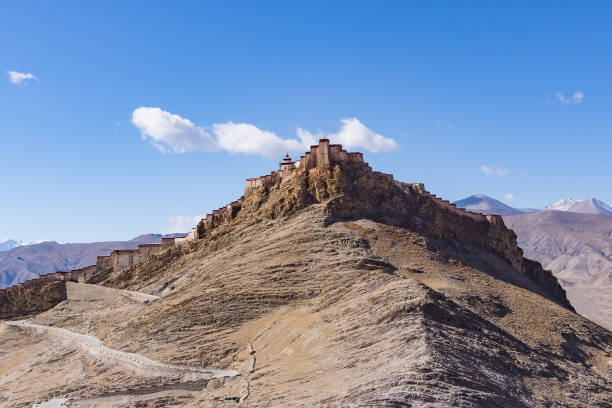
Gyantse Dzong.
Main Highlights: What You Absolutely Can’t Miss
Main Highlights: What You Absolutely Can’t Miss at Gyantse Dzong
Visiting Gyantse Dzong is akin to stepping back into a rich tapestry of Tibetan history and culture. Nestled atop a hill with sweeping views, this fortress offers not only breathtaking panoramas but also a deep connection to the turbulent past of Tibet. Here are the must-see highlights that you absolutely cannot miss during your visit:
1. The Historic Fortress Itself
The Dzong’s architectural charm is reminiscent of the Potala Palace, albeit on a smaller scale. As one of the few remaining Dzongs from the 14th century, its structure embodies the traditional Tibetan palace style, making it a fascinating site for architecture enthusiasts and history buffs alike. The journey to the top, though steep, rewards you with a stunning view of Gyantse’s whitewashed buildings, the fertile Nyang Chu Valley, and the iconic Kumba Stupa.
2. The Panoramic Views
The ascent to Gyantse Dzong may be challenging due to the altitude (over 4,140 meters), but the 30-minute hike is a worthwhile endeavor. Once you reach the summit, take a moment to absorb the sweeping vistas of the surrounding landscapes. The juxtaposition of the fortress against the backdrop of the valley and mountains is nothing short of breathtaking, offering a perfect opportunity for photography and reflection.
3. The Legacy of the Tibetan Defenders
Explore the poignant history etched into the very stones of the Dzong. One of the most significant spots is the “Jump Off Cliff,” where brave Tibetan defenders leapt to their deaths during the British invasion of 1904 rather than surrender. This site symbolizes courage and sacrifice, and it’s essential to pause and reflect on the stories of those who fought valiantly to protect their homeland.
4. The Anti-British Battery
Visit the remains of the Anti-British Battery, where Tibetan soldiers valiantly defended the Dzong against British forces. You can see the ancient cannons that were used during the conflict, offering a tangible link to the fierce resistance that took place here. Engaging with this site allows you to appreciate the struggle and resilience of the Tibetan people throughout their tumultuous history.
5. Ambans’ Stone Tablet
Don’t miss the Ambans’ Stone Tablet, which stands as a historical marker of the British presence in Gyantse. This tablet is a testament to the complex relationship between Tibet and foreign powers during the late 19th and early 20th centuries. It serves as an important reminder of the past and provides context for the events that unfolded in this region.
6. The Murals and Architecture
As you wander through the fortress, take the time to admire the preserved murals that adorn the walls. These artworks, influenced by both Newari and local styles, tell stories of Tibetan Buddhism and the region’s history. The intricate designs and vivid colors are a feast for the eyes and offer insight into the cultural significance of the Dzong.
7. The Surrounding Historical Context
While exploring Gyantse Dzong, it’s crucial to appreciate its historical context within the broader narrative of Tibet. The rise and fall of Gyantse as a political and religious center is a tale of ambition, struggle, and resilience. Engaging with this history enhances your visit and allows you to understand the significance of the Dzong beyond just its physical presence.
Tips for Your Visit
- Altitude Awareness: Take your time while ascending to avoid altitude sickness. Drink plenty of water and pace yourself.
- Photography: Bring a camera to capture the stunning views and the intricate details of the Dzong’s architecture.
- Timing: Plan your visit during the summer or autumn months when the weather is more favorable for hiking and exploring.
Embarking on your journey to Gyantse Dzong will not only immerse you in the majestic beauty of the landscape but also connect you with the rich and complex history of Tibet. Each step you take within this fortress echoes the stories of bravery and cultural heritage that continue to resonate through time.
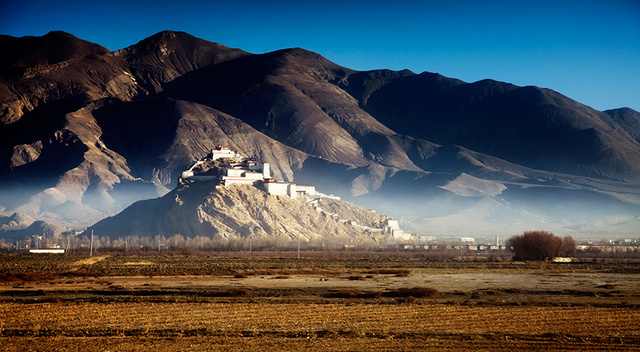
Gyantse Dzong.
Planning Your Visit: A Practical Guide
Planning Your Visit: A Practical Guide to Gyantse Dzong
Gyantse Dzong, a historic fortress perched dramatically above Gyantse County, is an essential stop for travelers seeking to immerse themselves in the rich tapestry of Tibetan history and culture. This guide will equip you with all the practical information you need for a memorable visit.
Getting There
Location: Gyantse Dzong is situated in Gyantse County, within Shigatse Prefecture, approximately 254 kilometers (158 miles) southwest of Lhasa. The fortress is easily accessible from the town of Gyantse.
Transportation Options:
– By Bus: Regular buses run from Lhasa to Gyantse. The journey takes about 6-7 hours, with stunning views of the Tibetan landscape along the way.
– Private Car: For more flexibility, consider hiring a private vehicle or joining a tour. This option allows for stops at significant sites along the route.
– Train: If you prefer to travel by train, the nearest railway station is in Shigatse, from where you can take a bus or taxi to Gyantse.
Best Time to Visit
The ideal times to visit Gyantse Dzong are during the summer (June to August) and autumn (September to October). During these months, the weather is generally mild and dry, making the climb to the fortress more enjoyable. However, be prepared for cooler temperatures at higher altitudes, especially in the evenings.
What to Expect
Upon arriving at Gyantse Dzong, you’ll be greeted by its imposing structure, reminiscent of a smaller Potala Palace. Here’s what to anticipate during your visit:
- The Climb: The path to the top of the Dzong takes approximately 30 minutes. Although only about 100 meters high, the altitude (over 4,000 meters) makes the ascent a bit challenging. Take your time and enjoy the views—rushing can lead to altitude sickness.
- Panoramic Views: Once at the top, you’ll be rewarded with breathtaking vistas of Gyantse’s whitewashed buildings, the fertile Nyang Chu Valley, and the nearby Palcho Monastery.
- Historical Significance: Explore the ruins and structures within the fortress, including the Anti-British Battery and the Jump Off Cliff site, which commemorate the bravery of Tibetan defenders during the British invasion in 1904.
Essential Tips
- Altitude Sickness: Be mindful of the symptoms of altitude sickness. Ascend slowly, stay hydrated, and consider acclimatizing in Lhasa before your trip.
- Footwear: Wear comfortable shoes suitable for walking on uneven terrain. The stairs can be slippery, so tread carefully on your descent.
- Photography: The Dzong offers numerous photo opportunities, so bring your camera. Early morning or late afternoon light is particularly beautiful for photography.
- Respect Local Culture: Gyantse is a culturally rich area. Be respectful of local customs, especially when visiting religious sites.
Nearby Attractions
While Gyantse Dzong is a highlight, consider extending your visit to explore other nearby attractions:
– Palcho Monastery: A short walk from the Dzong, this monastery is known for its stunning architecture and vibrant murals.
– Kumbum Stupa: Located within the Palcho Monastery complex, this unique structure features numerous chapels and is a must-see for its intricate designs.
Conclusion
Visiting Gyantse Dzong is not just a journey to a historical site; it’s an opportunity to connect with the resilient spirit of Tibet. Prepare for your adventure thoughtfully, and you’ll leave with memories that will last a lifetime. Whether you’re captivated by the stories of its past or the beauty of its surroundings, Gyantse Dzong promises an enriching experience in the heart of Tibet.
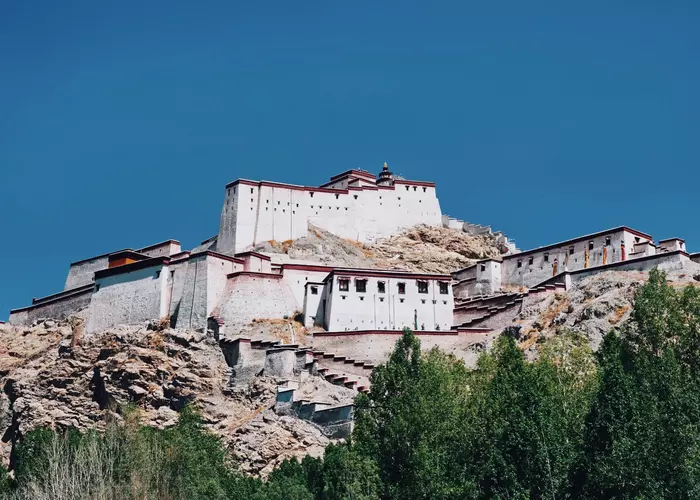
Gyantse Dzong.
Tickets: Prices, Booking, and Tips
Visiting Gyantse Dzong is a captivating experience that combines rich history with stunning architecture. To make the most of your trip, here’s everything you need to know about tickets, pricing, booking options, and some handy tips.
Ticket Information
Entry Fee: The ticket price for Gyantse Dzong is approximately 30 CNY (around $5 USD). This fee grants you access to the fortress and its surrounding areas, where you can explore the historical significance and breathtaking views of Gyantse and its surroundings.
Opening Hours: The Dzong is typically open from 8:00 AM to 6:00 PM. It’s advisable to arrive early to avoid crowds and enjoy the serene atmosphere of this ancient site.
Booking Options
While tickets can usually be purchased on-site, it’s a good idea to check with local tour operators for any combined packages. Many travelers opt for guided tours that include Gyantse Dzong as part of larger itineraries, such as:
- 6 Days Lhasa Gyantse Shigatse Tour: This tour provides an in-depth look at Tibetan culture, including visits to other notable sites.
- 8 Days Lhasa to Kathmandu Overland Tour: Experience breathtaking scenery and cultural treasures, with Gyantse Dzong as a highlight.
If you’re considering a guided tour, booking in advance is recommended, especially during peak travel seasons (summer and autumn) when demand is high.
Tips for Your Visit
-
Altitude Awareness: Gyantse Dzong is located at an altitude of about 4,140 meters (13,600 feet). If you’re coming from lower elevations, allow time for acclimatization to avoid altitude sickness. Take it slow during your ascent to the Dzong.
-
Best Views: To fully appreciate the panoramic views, plan to hike to the top of the Dzong early in the morning or late in the afternoon. The lighting during these times enhances the picturesque landscape of Gyantse’s old town and the surrounding valleys.
-
Comfortable Footwear: Wear sturdy shoes suitable for walking on uneven surfaces. The path can be steep and slippery, particularly on the descent.
-
Photography: Don’t forget your camera! The Dzong offers incredible photo opportunities, both of the fortress itself and the surrounding scenery. Capture the essence of this historical site while being respectful of local customs and traditions.
-
Local Guides: Consider hiring a local guide who can provide insights into the history and significance of Gyantse Dzong. This can enrich your understanding and appreciation of the site.
By planning ahead and being mindful of the unique challenges posed by the altitude, you can ensure a memorable visit to Gyantse Dzong. Enjoy your journey into the heart of Tibetan history!
How to Get There: A Complete Transportation Guide
Reaching Gyantse Dzong, the majestic fortress that stands as a testament to Tibetan history and architecture, is an adventure in itself. Nestled in Gyantse County, Shigatse Prefecture, this historical site is accessible through various modes of transportation, ensuring that international travelers can easily plan their visit.
Getting to Gyantse
By Air
The nearest major airport to Gyantse is Lhasa Gonggar Airport (LXA), located approximately 280 kilometers away. International travelers typically fly into Lhasa first, which serves as a gateway to Tibet. From Lhasa, you can arrange for a domestic flight to Shigatse Peace Airport (RKZ), which is about 90 kilometers from Gyantse.
Tip: It’s essential to book your flights in advance, especially during peak tourist seasons (May to October), to secure the best fares and availability.
By Train
An alternative and scenic route is to take a train to Lhasa. The Qinghai-Tibet Railway is renowned for its breathtaking views, and train travel is one of the most popular ways to experience Tibet. Once in Lhasa, you can continue your journey to Gyantse by road.
By Road
Traveling by road from Lhasa to Gyantse is a common option and offers stunning landscapes along the way. The distance is approximately 254 kilometers (about 5-6 hours drive). You can opt for a private vehicle, join a guided tour, or take a bus.
-
Private Car or Tour: Hiring a private car or booking a guided tour is the most convenient way to travel, as it allows for flexibility in your itinerary and stops along the way, including at attractions like Yamdrok Lake and Shigatse.
-
Public Bus: For budget travelers, there are regular public buses that operate between Lhasa and Gyantse. Buses leave from Lhasa’s main bus station and take about 6-7 hours. Always check the latest bus schedules, as they can change.
Local Transportation in Gyantse
Once in Gyantse, getting to Gyantse Dzong is straightforward:
-
Walking: The Dzong is located on a hill overlooking the town. It is a pleasant walk from the center of Gyantse, taking about 20-30 minutes. The scenery along the way is beautiful, making the trek enjoyable.
-
Taxis: Local taxis are available and can take you directly to the entrance of Gyantse Dzong if you prefer not to walk.
Important Considerations
-
Permits: Ensure you have the necessary travel permits for Tibet, including the Tibet Travel Permit, which is mandatory for all travelers. These permits can typically be arranged through travel agencies or tour operators in advance.
-
Altitude: Gyantse Dzong sits at an altitude of 4,140 meters (13,583 feet). It’s advisable to acclimatize properly in Lhasa before heading to Gyantse to minimize the risk of altitude sickness.
-
Best Time to Visit: The ideal time to visit Gyantse is during the summer and autumn months (May to October), when the weather is mild and the landscape is at its most vibrant.
With its rich history and breathtaking views, Gyantse Dzong is a must-visit destination. By planning your transportation thoughtfully, you can ensure a smooth journey to this remarkable piece of Tibetan culture.
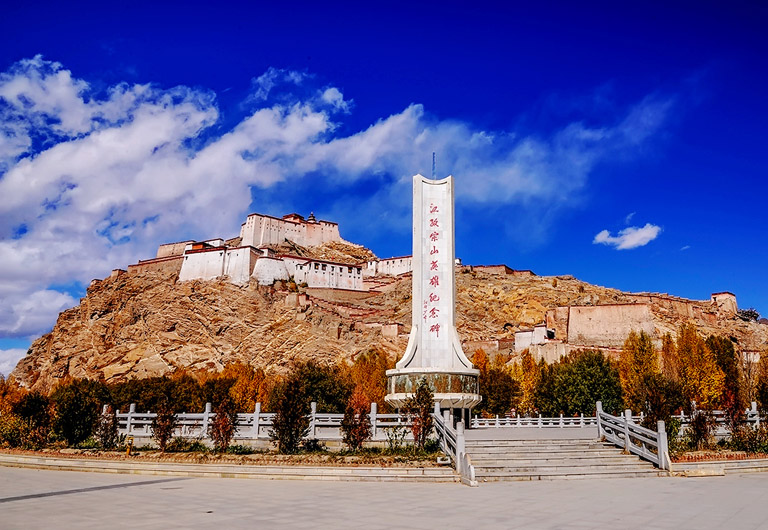
Gyantse Dzong.
Local Cuisine and Accommodation Nearby
When visiting the majestic Gyantse Dzong, travelers will want to indulge in the local cuisine and find comfortable accommodations that enhance their experience of this historic site. Gyantse, a charming town in Tibet, offers a unique blend of traditional Tibetan flavors and welcoming places to stay.
Culinary Delights
Local Restaurants
-
Gyantse Restaurant
Located near the town center, this eatery is a favorite among both locals and tourists. It serves authentic Tibetan dishes, including momos (steamed dumplings filled with meat or vegetables), thukpa (noodle soup), and hearty tsampa (roasted barley flour). The cozy atmosphere and friendly service make it a perfect spot to savor the flavors of Tibet after a day of exploring. -
Jiangsu Restaurant
This restaurant offers a fusion of Tibetan and Chinese cuisine, providing an array of options for every palate. Try their yak meat stir-fry or vegetable fried rice. The setting is casual, and it’s a great place to unwind and recharge before delving back into the rich history of Gyantse. -
Tashi’s Cafe
A charming little cafe that prides itself on serving organic, locally sourced food. Tashi’s Cafe features delicious Tibetan tea, fresh salads, and a variety of baked goods. Don’t miss their sweet tea and butter tea, which are perfect for acclimatizing to the altitude.
Accommodation Options
Where to Stay
-
Gyantse Hotel
This hotel is conveniently located just a short walk from Gyantse Dzong. It offers comfortable rooms with stunning views of the fortress and the surrounding valley. The hotel provides essential amenities such as Wi-Fi, and its restaurant serves a delightful menu of Tibetan and Chinese dishes, making it an ideal base for your adventures. -
Yamdroktso Hotel
For travelers seeking a more budget-friendly option, Yamdroktso Hotel offers clean and simple accommodations. The staff is known for their hospitality, and the hotel is situated close to local attractions, including the famous Palcho Monastery. It’s a great choice for those looking to immerse themselves in the local culture without breaking the bank. -
Gyantse Dzong Homestay
Experience authentic Tibetan hospitality by staying at a homestay near the Dzong. Guests can enjoy home-cooked meals and engage with local families, providing a unique insight into Tibetan life. This option is particularly recommended for those who appreciate a personal touch and want to connect with the community.
Whether you’re fueling up with delicious local dishes or resting in cozy accommodations, Gyantse invites you to indulge in its rich culinary heritage and warm hospitality as you explore the historical marvel of Gyantse Dzong.

Gyantse Dzong.
Frequently Asked Questions
Frequently Asked Questions about Gyantse Dzong
1. What is Gyantse Dzong?
Gyantse Dzong, also known as Gyantse Old Castle, is a historic fortress located in Gyantse County, Shigatse Prefecture. It is renowned for its striking Tibetan architectural style and offers a glimpse into Tibet’s rich history, including its resistance against British invasions in the early 20th century.
2. How do I get to Gyantse Dzong?
Gyantse Dzong is accessible from Gyantse Town. You can reach Gyantse by bus or private vehicle from Lhasa, Shigatse, or other nearby towns. Once in Gyantse, the Dzong is a short walk from the town center, with clear signage directing visitors.
3. What should I wear when visiting Gyantse Dzong?
Dress in layers to accommodate the varying temperatures at high altitudes. Comfortable walking shoes are essential, as the path to the Dzong can be steep and uneven. Don’t forget to bring a hat and sunscreen to protect against the strong sun.
4. Is there an entry fee for Gyantse Dzong?
Yes, there is typically a small entrance fee to visit Gyantse Dzong. Be sure to check for any updates on pricing or additional fees for guided tours.
5. What is the best time to visit Gyantse Dzong?
The ideal times to visit Gyantse Dzong are during the summer and autumn months (June to October), when the weather is milder and the views are clearer. However, be prepared for cooler temperatures at night, even in summer.
6. Are there facilities like restrooms and food available near Gyantse Dzong?
While there may not be restrooms directly at the Dzong, you can find facilities in Gyantse Town before your visit. As for food, there are several local eateries nearby where you can enjoy traditional Tibetan dishes.
7. How physically demanding is the hike to Gyantse Dzong?
The hike to Gyantse Dzong is moderate but can be challenging due to the high altitude (4,140 meters). It takes about 30 minutes to reach the top, so pace yourself to avoid altitude sickness. Walking slowly and taking breaks is recommended.
8. Can I take photographs in Gyantse Dzong?
Yes, photography is allowed in and around Gyantse Dzong, but be respectful of any restrictions that may apply inside temples or specific areas. Capture the stunning views and the intricate details of the fortress as a memorable part of your journey.
Final Thoughts on Your Trip
As you prepare to leave Gyantse Dzong, take a moment to reflect on the profound beauty and rich history that envelops this remarkable fortress. Standing sentinel over the town, the Dzong is more than just an architectural marvel; it is a testament to the resilience and spirit of the Tibetan people. From its storied past, marked by battles and bravery, to the breathtaking views of Gyantse’s landscape that stretch far beyond its ancient walls, your experience here is bound to resonate long after your visit.
Walking the winding paths of the Dzong, you not only traverse the remnants of history but also connect with the enduring culture and traditions of Tibet. The echoes of countless stories from the Tibetan defenders who once resided here remind us of the valor and sacrifice that have shaped this land.
As you gaze out over the fertile Nyang Chu Valley and the charming whitewashed buildings of Gyantse, you might find yourself inspired by the juxtaposition of past and present—a reminder that history is not just to be learned, but to be felt and cherished.
With its unique blend of natural beauty and cultural significance, Gyantse Dzong invites you to carry its stories with you, enriching your journey through Tibet and beyond. So take the memories of this extraordinary place with you, and let them inspire your travels ahead.